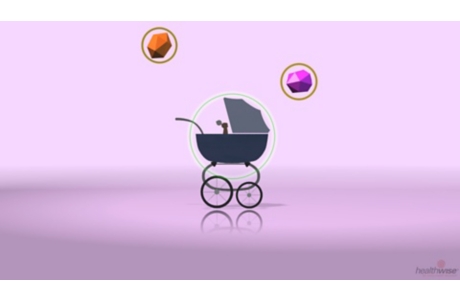Overview
Children usually move in natural, predictable steps as they grow and develop language, cognitive, social, and sensory and motor skills. But each child gains skills at their own pace. It's common for a child to be ahead in one area, such as language, but a little behind in another.
At routine checkups, your child's doctor will check for milestones. This is to make sure that your child is growing and developing as they should. Your doctor can help you know what milestones to watch for as your child gets older. Or you can look for sources of information and support nearby. Public health clinics, parent groups, and child development programs may help. Knowing what to expect can help you spot problems early. And it can help you feel better about how your child is doing.
Talk with your doctor about any concerns you have about your child's health, growth, or behavior. Do this even if you aren't sure what worries you.
Your relationship with your child will change as your child gains new skills and develops independence. As your child's world gets bigger, you can help your child grow in healthy ways. Here are a few things you can do. Spend time together. Be a good role model. Show your child love and affection.
Health Tools
Health Tools help you make wise health decisions or take action to improve your health.
What to Expect
The ages from 2 to 5 are often called the preschool years. During these years, children change from clumsy toddlers into lively explorers of their world. A child develops in these main areas:
- Physical development.
- In these years, a child becomes stronger and starts to look longer and leaner. Physical development slows down from the rapid growth during infancy. From age 2 through age 5, most children gain about 3 lb (1.5 kg) to 5 lb (2.5 kg) a year and grow about 3 in. (8 cm) a year.
- Cognitive development.
- A child this age makes great strides in being able to think and reason. Children progress from a simple to a more complex understanding of time, letters, counting, and colors. Children are able to follow increasingly more detailed commands.
- Emotional and social development.
- Between the ages of 2 and 5, children gradually learn how to manage their feelings. At age 2, children are excited about being around other children. But most children at this age play near each other rather than with each other. (This is called parallel play.) By age 5, most children seek and enjoy friendships.
- Language.
- Language develops quickly between ages 2 and 5. By age 2, most children can say at least 50 words. By age 3, children can speak at least 200 words. They can also follow two-part directions, such as "Wash your face and put your shoes away." Most 5-year-olds can carry on a conversation.
- Sensory and motor development.
- By age 2, sensory and motor skills become more refined. Children go from being able to walk up stairs, kick a ball, and draw simple strokes to being able to do basic tumbling and draw rough figures of people and other recognizable objects. By age 5, most children can dress and undress themselves and write some lowercase and capital letters.
Each child grows and gains skills at their own pace. It's common for a child to be ahead in one area, such as language, but a little behind in another.
Learning what is normal for children this age can help you spot problems early or feel better about how your child is doing.
Learn more
- Emotional Development, Ages 2 to 5 Years
- Language Development Between 12 and 24 Months of Age
- Milestones for 2-Year-Olds
- Milestones for 3-Year-Olds
- Milestones for 4-Year-Olds
- Milestones for 5-Year-Olds
- Sensory and Motor Development, Ages 12 to 24 Months
- Speech and Language Development
- Speech and Language Milestones, Ages 3 to 5 Years
Common Concerns
It's common for parents to have questions about their child's sleep, safety, toilet training, and difficult emotions and behavior.
Sleeping
Preschool children need about 10 to 14 hours of sleep each day, depending on their age.footnote 1 Your child may go through phases of resisting rest.
To help foster good sleep habits, you can:
- Set bedtime routines.
- Do things in the same order each night. Then your child can understand what to expect and can link these steps with going to sleep.
- Handle sleep disturbances.
- Keep your response the same each time your child wakes up.
- Help prevent stress before bedtime.
- Avoid reading scary stories and watching scary programs that might cause your child to worry. Stress may cause nightmares.
- Manage night terrors.
- Reassure and hold your child to prevent injury.
Safety
To help keep your child safe, it's very important to be aware of your child's abilities and the environment, whether it is the home, a playground, or a public place. These abilities change as your child grows and gains new skills.
Toilet training
Most children are ready for toilet training when they show interest in using the toilet. It is okay to delay toilet training until your child is ready.
Behavior
Children ages 2 to 5 have many intense emotions that they don't fully understand. As a result, expect your young child to not always listen to you. Be patient. Do your best to be consistent about setting limits to avoid some common issues. These may include:
- Temper tantrums.
- Thumb-sucking.
- Breath-holding spells.
- Aggressive behavior.
Learn more
Promoting Healthy Growth and Development
You can help your child grow by showing love and affection, by talking with and reading to your child, and by letting your child play. It's also important to set boundaries and limits.
- Offer plenty of opportunities for exercise.
Going to the playground, joining a gymnastics or dance class, or simply running races in your backyard allows your child to release excess energy. And it encourages new physical skills.
- Help your preschooler learn healthy eating habits.
You control what, when, and where your child eats. But remember that your child chooses whether to eat and how much. As long as you offer nourishing foods and focus on the big picture—how much your child eats each day or over a few days—your child should be okay.
- Encourage safe exploration.
Children who explore learn to master new skills and solve problems. Offer a variety of things to play with, read, create, and build. Take basic steps to reduce risks.
- Encourage a sense of security.
This sense of trust lays the foundation for learning, social skills, adaptability, and emotional development. Your child is more likely to feel safe and secure if you are dependable, consistent, respectful, and responsive. Secure children also keep and strengthen their attachment to their parents.
- Provide peer contact.
Playing with other children even 1 day a week gives children the chance to practice and develop important social, emotional, and language skills.
- Promote self-control.
Children need guidance, clear limits, and patient parents during this time of behavioral and emotional struggles. Help your child by modeling and teaching proper behavior. Time-outs can help, when they are used properly and sparingly. Encourage your child to think about how other people feel. This helps your child learn empathy.
- Help your child build self-esteem.
Parents have the greatest influence on a child's self-esteem. Let your child know that your child belongs, is doing well, and is contributing.
- Read to your child at every age.
Reading exposes your child to the sounds and rhythm of language.
- Help your child talk with others.
Listening to and talking with other children and adults helps a child to understand and use language.
- Provide a variety of experiences and play environments.
Schedule time each day for either indoor or outdoor physical activity, such as dancing or going to a playground. These activities improve coordination and other large muscle skills. Fine motor skills develop through things such as art projects (like painting or using clay) and playing musical instruments.
If you are the parent or caregiver of children, it is also important for you to:
- Learn and use effective parenting and discipline techniques. Avoid spanking. Parenting classes are offered in most communities. Ask your doctor or call a local hospital for more information.
- Learn healthy techniques to resolve conflicts and manage stress.
- Ask for help when you need it. Call a family member or friend to give you a break if you feel overwhelmed. Find community resources to help you with child care or other services that you need. Call a doctor or local hospital for a place to start. Some communities have respite care facilities for children. They provide temporary child care during times when you need a break.
- Get help from school programs if your child has special needs.
- Seek help if you think you have a problem with alcohol, drugs, anger, depression, stress, or other issues that affect your mental health.
Nurturing your relationship with your child
Your relationship with your child will constantly change as your child gains new skills and develops independence. You can help your child through each stage by looking at your relationship from time to time. Ask yourself:
- What do I like most about my child?
- What could be triggering problem behavior? Are any of these new triggers?
- What new skills has my child learned in the past 3 months? 2 months? 1 month?
- What tasks can I encourage my child to do on their own? How can I encourage my child?
- When am I happy about how I treat my child?
- What don't I like about some of our interactions? When do these episodes tend to occur?
Getting ready for kindergarten
Most children start kindergarten around age 4½ to 6 years.
It can be hard to know when your child is ready for school. But your local elementary school or preschool can help. Going to preschool or play groups can be a great way for children to build new skills and learn to interact with others.
Here are some of the tasks and behaviors that show that a child is ready for kindergarten.
- Your child can share, take turns, interact with other children, and follow directions.
- Your child knows the letters of the alphabet when they are out of order. Your child knows and can write his or her first and last name with uppercase and lowercase letters.
- Your child can listen to a story and answer questions about the story.
- Your child knows the numbers 0 to 10 out of order, can count to 20 while pointing to objects, and can name colors and shapes.
Learn more
- Educational Rights for Children With Disabilities
- Effective Parenting: Discipline
- Encouraging Language Development in Your Preschooler
- Helping Your Child Build Self-Esteem
- Healthy Eating for Children
- How Reading Helps Language Development
- Managing Your Toddler's Frustrating Behaviors
- Physical Activity for Children and Teens
- Preschoolers: Building a Sense of Security
- Preschoolers: Building Self-Control
- Preschoolers: Building Social Skills
- Preschoolers: Encouraging Independence
- Preschoolers: Helping Your Child Explore
- Speech and Language Development: Helping Your 1- to 2-Year-Old
- Time-Out
Watch
When to Call a Doctor
Call 911 or other emergency services if you become so frustrated with your child that you are afraid you might cause your child physical harm.
In general, talk to a doctor anytime your child:
- Does not seem to be reaching developmental milestones as expected.
- Is not growing at a steady pace. Each year between ages 2 and 5 years, expect your child to gain about 3 lb (1.5 kg) to 5 lb (2.5 kg) and grow as much as 3 in. (7.6 cm). Your child's height and weight are measured at routine well-child exams. But call your doctor if your child's growth pattern concerns you in between these visits.
- Is not able to do some of the things that they used to do, such as talking or running.
- Acts overly aggressive, violent, or verbally abusive.
- Doesn't seem to be doing well, even though you can't pinpoint what makes you uneasy. Friends and other caregivers may also be concerned.
Although children grow at their own pace, be aware of signs of a developmental delay. The earlier you identify a delay, the better chance you have of getting the right treatment for your child that can prevent or minimize long-term problems.
Routine Checkups
Routine checkups usually are scheduled several times during ages 2 to 5. These routine checkups are called well-child visits. They are important to check for problems and to make sure that your child is growing and developing as expected.
Physical exam
The doctor typically will:
- Measure your child's weight and height. These measurements are plotted on a growth chart to see how your child compares to other children of the same age. This chart is updated at each routine exam to document the child's growth pattern.
- Check your child's blood pressure.
- Examine your child for any visible problems.
- Ask you about your child's eating and sleeping habits.
- Review your child's immunization record. Needed vaccines are given or scheduled.
Mental and emotional health
The doctor will talk with both you and your child to get a sense of your child's mental, emotional, and social development. Questions typically cover:
- Whether any noticeable behavioral changes have occurred.
- Your child's and family's general well-being. The doctor also looks at how you and your child interact.
- How your child reacts to strangers.
- How your child plays and interacts with peers.
- Whether you have any concerns about issues such as toilet training, preschool, or troubling behaviors.
- Your child's language, hearing, and social skills. The doctor asks your child questions to briefly assess these and related developmental issues. For example, the doctor may ask your child about favorite activities and the names of friends.
Along with the above assessments, doctors usually ask questions specific to a child's age.
Caring for your child's teeth is also important for your child's health. Schedule regular dentist visits every 6 months or as your dentist recommends.
Well-child visits are a good time to talk with your doctor about any concerns you have about your child's health, growth, or behavior. Between visits, write down any questions you want to ask the doctor next time.
Learn more
Watch
Related Information
- Bed-Wetting in Children
- Biting
- Choosing Child Care
- Environmental Illness
- Health and Safety, Ages 2 to 5 Years
- Health Screening: Finding Health Problems Early
- Healthy Eating for Children
- Immunizations
- Managing Your Toddler's Frustrating Behaviors
- Preventing Poisoning in Young Children
- Quick Tips: Getting Active as a Family
- Speech and Language Development
References
Citations
Credits
Current as of: October 24, 2023
Author: Healthwise Staff
Clinical Review Board
All Healthwise education is reviewed by a team that includes physicians, nurses, advanced practitioners, registered dieticians, and other healthcare professionals.
Current as of: October 24, 2023
Author: Healthwise Staff
Clinical Review Board
All Healthwise education is reviewed by a team that includes physicians, nurses, advanced practitioners, registered dieticians, and other healthcare professionals.




